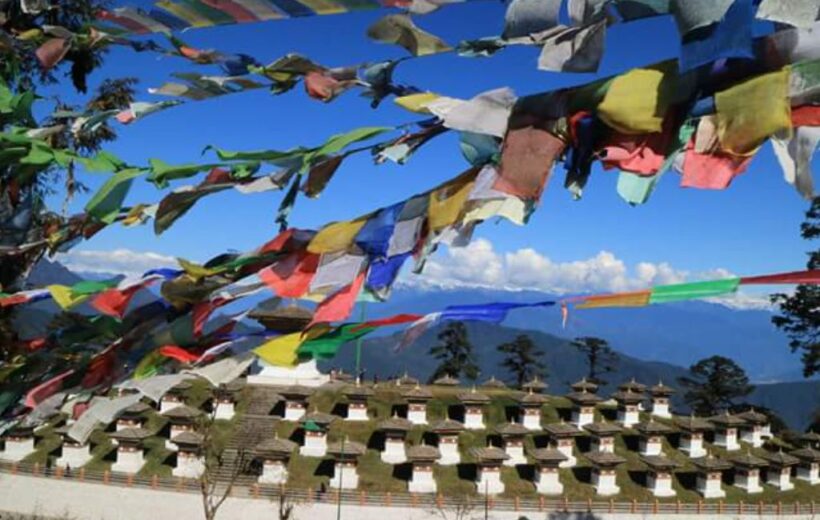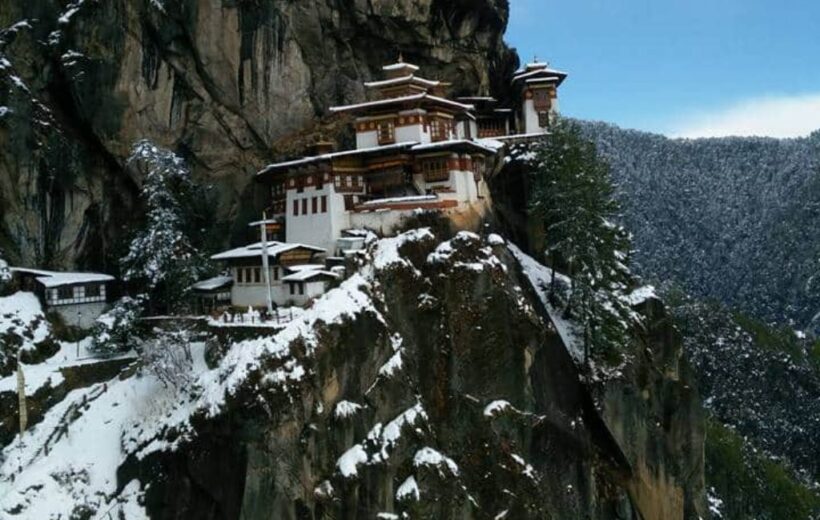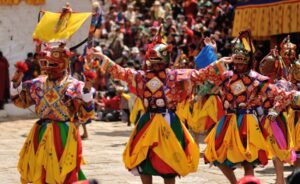West,East Bhutan Tour
Duration
Tour Type
Overview
This 15-day Bhutan tour begins with a flight to Paro, featuring iconic cultural landmarks such as the Tiger’s Nest Monastery, Ta Dzong Museum, and Drukgyel Dzong. It explores picturesque valleys like Haa and Phobjikha, and towns like Thimphu, Punakha, and Bumthang, showcasing Bhutanese monasteries, temples, and traditional lifestyles. The journey ends with a transfer from Samdrup Jongkhar to Guwahati, India.
Tour Plan
Day-01: Arrive Paro-.Altitude 2200m.
The flight to Paro is one of the most spectacular mountain flights in the world, with a constantly changing panorama of some of the highest mountains on earth. Our Bhutan representative will meet you at Paro airport exit doors following customs formalities. After lunch enjoy afternoon sightseeing around Paro, including a visit to the Ta Dzong Museum housing many religious relics, works of art and handicrafts offering a great orientation into Bhutan’s historical, cultural, and religious past. Next, visit the Rimpong Dzong to see the painting of the great saint Milarepa. Dzong’s are large monasteries and district administrative centres, which were once strategic forts. Before dinner at the hotel there will be an orientation on Bhutanese etiquette by your guide. Overnight at your hotel in Paro.
Day-02:Paro:
After breakfast hike to Taktsang (Tigers nest) Monastery. The walk of approximately 1.5 to 2 hours uphill takes you almost a kilometre above the Paro valley floor (for those who cannot hike we will arrange a horse for transfer up to cafeteria). The view of Taktsang Monastery built on a sheer cliff face 900 metres above the valley floor is a spectacular sight. The Monastery is an important pilgrim site for Buddhists. The great Guru Rimpoche is said to have flown here on the back of a tigress when he brought the teachings of the Buddhist Dharma to Bhutan in the 8th Century. Afterwards drive to the ruins of the 17th Century Drukgyel Dzong, and 7th Century Kyichu Lhakhang, one of the 108 temples constructed by the Tibetan king Songtsen Gampo. Overnight in hotel.
Day-03:Paro- Day excrussion to Haa valley:
After breakfast drive to the Haa Valley, one of the most picturesque districts in Bhutan. Reached via the beautiful Chelila Pass (3900m), Haa Valley is characterized by its surrounding rugged and mountainous terrain and unique architecture.After lunch drive back to paro . One day way make a hike to Nunnery. Overnight in hotel.
Day-04: Paro- Thimphu- Altitude 2200m/65 km/2hrs drive:
After breakfast drive to the capital, Thimphu (1.5 hours). Once a rustic village sitting in a broad river valley, Thimphu is today the nation's capital. Enjoy a full day of sightseeing, including a visit to the National Memorial Chorten, built by the Royal Queen Mother as a memorial stupa for the Third King. Continue on to 12th century Changangkha Temple and the Zilukha Nunnery.Visit Buddha point to take beautiful shot of Buddha and the valley. The big statue of sitting Buddha is located on the hill of Thimphu valley. The statue is made of bronze and the high of the statue is 169ft (51.5m). If your visit coincides with the weekend, you can walk through the Thimphu Market. Overnight in hotel.
Day-05:Thimphu:
After breakfast drive north through the suburbs for about 40min to Dodena and walk up to Cheri Gompa Monastery (2850m) Cheri Gompa was first built in 1620 by shabdrung and it was here that the central monastic body (Dratsang) was first established. Many of the important priests of Drukpa Kagyul lineage passed periods here, and so it is an important pilgrim site for Bhutanese. During the weekends, many Bhutanese are seen climbing up the hill from Dodena (2,600m), where the road ends. Cross a wooden cantilever bridge and climb up the hill with moss-laden pine, fir and rhododendron trees, that takes little over 1 hour. Return to the road. Picnic lunch will be serving. After lunch drive back to Thimphu city go to hotel relax for some time.In the evening visit Thimphu Tashi chhe Dzong.Thimphu Dzong is very important. This Dzong is summer resident for 100 monks and in winter 1000 monks go to Punakha valley for winter resident. This tradition is practice from long time ago. Inside the Dzong there is very important temple where king of Bhutan crown.4th and 5th king was crown in Thimphu Dzong.1st and 2nd king was crown in punakha Dzong and 3rd king was crown in Paro Dzong.Overnight in hotel.
Continue sightseeing in Thimphu. Visit the School for Arts and Crafts, The National Library housing the collection of Bhutanese scriptures dating back to the 8th century, the Traditional Paper Factory and a fascinating replica of a medieval farmhouse at the Folk Heritage Museum. If there is time, you may visit the nursing pen for the Takin, the national animal of Bhutan, and Tashichhodzong, ‘the fortress of the glorious religion’ housing some ministries, His Majesty’s secretariat, and the central monk body. Other options for the day include a hike to Tango and Cheri Monasteries (45 mins), two of the most ancient monasteries in the Thimphu region. Overnight at your hotel in Thimphu.
Day-06: Thimphu-Punakha- Altitude 1300m/77km/2hrs drive:
After drive to punakha the road climbs from Thimphu to Dochula Pass (3050m) and descends through ever changing forests into semi-tropical valley of Punakha at around 1250mEn-route stops at dochula Pass (3050m) where you can view the eastern Himalayas, including Bhutan’s highest mountain, Gangkhar Punsum (7550m). Visit Chime Lhakhang: The monastery and fertility temple dedicated to Lama Drukpa Kuenley, a Tibetan Buddhist saint known popularly as “the divine madman” and considered a folk hero in Bhutan for his unconventional ways. Drukpa Kuenley originally built a chorten on the site in the 14th century, on which a temple was later built in 15th century. The temple, flanked by nearly 100 tall prayer flags, sits atop a picturesque hill. It has long been a pilgrimage site for childless couples. This easy walk takes about ½ hour each way. After Lunch (Agriculture activity) visit farm house to see the life style and how they live in village. Try to find out how village life and city life. Experience yourself working with farmers. Village life is very hard than city life. Overnight in hotel.
Drive over the Dochu-La pass (3,100 meters), which on a clear day offers an incredible view of Himalayan peaks before descending into the Punakha valley (3 hrs). In the Dochu-La area there are vast Rhododendron forests that grow to tree size and bloom in late April/early May covering the mountains in a riot of glorious spring colour.Punakha was the ancient capital of Bhutan. On arrival, visit Punakha Dzong, built in 1637 by the Shabdrung, the ‘Unifier of Bhutan’. The three story main temple of the Punakha Dzong is a breathtaking example of traditional architecture with four intricately embossed entrance pillars crafted from cypress and decorated in gold and silver. After lunch, enjoy a walk to Chimi Lhakhang, temple of Drukpa Kuenly. He inherited the Divine Madman title since he revolted against the orthodox Buddhism in his time. Overnight at your hotel in Punakha/ Wangdue.
Day-07: Punakha-Phobjikha. Altitude 2700m/75km/2hrs drive:
After breakfast transfer to Phobjikha Valley via the bustling market town of Wangduephodrang. Drive up a winding mountain road through oak and rhododendron forests, and over a high pass down into the picturesque Phobjikha Valley. Phobjikha is one of Bhutan’s few glacial valleys, and chosen winter home of black necked cranes (November - March) migrating from the Tibetan plateau. After lunch visit the Phobjikha Sanctuary to view the majestic black necked cranes (Nov-Mar only) visit Gangtey Gompa (Monastery), dating back to the 16th century and make a wonderful hour hike down to the valley from the Gangtey monastery overnight in hotel.
Day-08-Phobjikha-Trongsa. Altitude 2400m/70km/2hrs drive:
After late breakfast drive to Trongsa crossing over the Pele La pass (3,420m) on the Black Mountain range towards Trongsa. Enroute visit the beautiful 18th century Chendebji Chorten. Trongsa is the ancestral home of Bhutan’s ruling dynasty. Visit Trongsa Dzong, the largest Dzong in Bhutan and the Ta Dzong, now converted into museum. In the evening walk around the town. Overnight in hotel.
Day-09-Trongsa-Bumthang. Altitude 2700m/65km/2hrsdrive:
After breakfast proceed towards Bumthang the spiritual heart of the kingdom. Bumthang is home to some of Bhutan’s oldest Palaces, Buddhist temples and monasteries. On arrival, visit Jakar Dzong (Dzong of the White Bird) and 16th century Tamshing Lhakhang containing ancient Buddhist wall paintings. After lunch visit Kurje Lhakhang, one of the most sacred places in the kingdom and 7th Century Jambay Lhakhang. Overnight in hotel.
Day-10-Bumthang-Day excrussion to Tang valley:
After breakfast drive to Tang valley on the way visit burning lake where Pemalingpa (founder of the Nyingmapa sect) is said to have found treasure hidden by Guru Rinpoche in 8 century. Visit 16th century Tang Ugyen Chholing Palace museum containing an overview of traditional rural life in Bhutan. In the evening drive back to Bumthang. Overnight in hotel.
Day-11-Bumthang- Mongar- Altitude 1600m/165km/6/7 hrs:
The drive will be pretty long and cold toady crossing highest pass Thurimsing la in central and eastern Bhutan. In clear weather one the way you might see the view of the highest mountain of Bhutan (Gangkhar punsum). Ascend to the small pass of shertong la and the road leads to further down to the URA valley. Make a short stop in URA valley for a cup of tea. Continue ride to the highest pass in central and eastern Bhutan, Thurmisingla pass.. From here downhill road will starts to Mongar. One the way you will see the stunning view of Namling waterfall. The ride will be through the mountail cliff road. Ride carfully. This cliff road considered as dangerous. The road descend till the Limigthang and uphill to the Monger. Visit Mongar Dzong, built in the 1930's using the traditional process without either plans or the use of nails. Overnight in hotel.
Day-12-Mongar-Tashigang:
Drive to Trashigang (3 hrs) through leafy forests filled with ferns and over Kori-La Pass (2,450m) before descending through cornfields and banana groves to reach the famous road zigzag just below Yadi. Trashigang is the main township of the largest district in the country. After lunch visit Trashigang Dzong. Overnight in hotel.
Day-13: Trashigang (ExcursiontoTashiyangtse):
Visit the temple of Gom Kora and Doksum Village where you can see women busily weaving traditional Bhutanese fabric. The area is famous for its unique wooden crafts. Visit the Tashiyangtse Dzong, and the dazzling white stupa of Chorten Kora and the nearby institute for Zorig Chusum, where student are trained in Bhutan’s 13 traditional arts and crafts. Overnight at your lodge in Trashigang.
Day-14: Trashigang-Samdrupjongkhar:
After breakfast drive to Samdrup Jongkhar, the gateway to eastern Bhutan and border to Assam, India. On the way stop at khaling village. Continue drive to border town with many beautiful villages and landscapes on the way. Overnight in hotel.
Day-15-Samdrupjongkhar-Guwhati:
After breakfast, your guide will arrange an Indian vehicle for your transfer to Guwahati, for your onward flight.
Tour Map
Included/Excluded
- 3*hotel twin sharing
- 3 meals(Breakfast, Lunch and dinner)
- English speaking guide
- SDF
- Visa fees
- Transportation with driver
- Entrance fees
- International flight tickets
- Travel insurance
- Personal expenses
- Payment transfer fees
- Tips to service provider
- and any other cost which is not included in given cost
- Additional cost for 4* hotel and above
Frequently asked questions
Bhutan is a year-round destination. There are four seasons: summer (June to August), autumn (September to November), winter (December to February) and spring (March to May). But because of the range of altitudes in the country, and the influence of the north Indian monsoons, the climate is incredibly varied.
In the south, the humid, subtropical climate is fairly consistent year-round, with temperatures between 15oC and 30oC. Central Bhutan, with its temperate forests, has a more seasonal climate, with warm summers and cool, dry winters. The northern regions are much colder during winter. Because of the high altitude, mountain peaks are snowy year-round and the lower reaches remain cool in summer.
In summer, the Indian monsoon season runs from late June or July to late September, mostly affecting the southern regions. Most farming activities take place in the summer, when crops thrive in verdant landscapes.
Autumn, from late September or early October to late November, follows the rainy season. It is characterised by bright, sunny days and some early snowfall at higher elevations. It’s the season of feasts and festivals as farmers reap the fruits of their work.
From late November until March, the crisp, clear and sunny winter sets in, with frost throughout much of the country and snowfall common above elevations of 3,000 metres. The winter northeast monsoon brings gale-force winds at the highest altitudes through high mountain passes, giving Bhutan the name Drukyul, which means Land of the Thunder Dragon in Dzongkha (Bhutan’s national language).
Bhutan’s generally dry spring starts in early March and lasts until mid-April. It is a botanist’s delight, with nature in full bloom. Summer weather commences in mid-April with occasional showers and continues to late June.
Visitors of all nationalities, except those from India, require a visa before entering Bhutan. For all visitors, except those from Bangladesh and the Maldives, this visa must be applied for and approved in advance of travel. Visitors from Bangladesh and the Maldives also require a visa, but this can be applied for and approved either in advance of travel or upon arrival in Bhutan.
Visitors from India are able to apply for a permit but are required to hold an Indian passport or an Indian voter ID card. For Indian nationals under the age of 18, a passport or a birth certificate can be used to enter and they must be accompanied by a legal guardian.
Nationals from Switzerland and Thailand holding diplomatic or government-official passports are eligible for a visa at their port of entry.
A correctly input visa application can take up to five days to process.
The Sustainable Development Fee (SDF) is a daily levy paid by visitors to support Bhutan’s development. Since the kingdom first opened its doors in 1974, guests have played a critical role in our country’s growth.
The SDF is collected by the national exchequer and funds are allocated to various projects that create long-term, sustainable opportunities for the Bhutanese people, through free healthcare, education and training, upskilling the tourism and hospitality industry, improved infrastructure, environmental preservation and conservation, cultural preservation programmes and initiatives that support local businesses and economies. The SDF is also a vital means of maintaining the exceptional forest cover and carbon-neutrality for which our small nation is world-renowned and globally critical. The SDF also helps us to ensure that we can continue to offer guests tranquillity and an intimate experience.
The SDF is USD 100 per night for adults from all countries except for India. Children aged between 6 years and who have not yet turned 12 are eligible to pay USD 50 per night. Children who have not yet turned 6 years old do not have to pay any SDF.
The SDF for Indian nationals (showing a valid Indian passport or Voter ID card) is Nu. 1,200 (or the equivalent amount in Indian rupees) per person, per night. Children aged between 6 years and who have not yet turned 12 are eligible to pay Nu./INR 600 per night. Children who have not yet turned 6 years old do not have to pay any SDF.

















1 Comment
I had a great time in Bhutan! I really recommend a visit to this country if you want to have a great and different experience. I exclusively recommend Indostan Viajes Tours that provided me with this satisfying opportunity. The tour guide was brilliant and I was exposed to the original Bhutan.
Regards,
Comments are closed.